Understanding the Mission — Supporting the Mission
 At the heart of every faith-based organization are two core ideas. To achieve their goals, any such group needs one, a clear vision of what it wants to achieve and two, a specific methodology or mission, which will allow them to reach that goal.
At the heart of every faith-based organization are two core ideas. To achieve their goals, any such group needs one, a clear vision of what it wants to achieve and two, a specific methodology or mission, which will allow them to reach that goal.
Unfortunately, not every group does an equally solid job of putting those ideas into place and defining their target.
The unrealistic, unmanageable or — worse yet — unachievable mission (or flawed vision) can and often does present serious issues for anyone seeking to help that organization with technology or technical systems designed to serve their mission and help them achieve their stated vision.
In our many decades of working with all kinds of faith-based groups, spending a few hours early on in the relationship getting a clear and precise understanding of what THEY think they are trying to achieve and how THEY think they are going to get to that point can prove extremely enlightening — if not a bit frightening.
The numbers of times in the last 30+ years that I have heard a group’s plans for their facility or their technology infra-structure that were well outside the realities of their space or their budget are almost uncountable.
We forget, since we live with technology every day, 25/8, that the people we serve do not have the same level of understanding and more important, rarely have a true concept of the costs and complexities of a “need or want.” They state a goal as if it was a simple matter of wishing it into existence.
Unfortunately, reality will come crashing down on their party and it’s our job to both cushion that blow and find a way to guide them towards a feasible alternative solution that still gets them close to their stated vision and plan for mission parameters.
So how do you manage unrealistic or unreachable goals and concepts without either losing the customer or disappointing them?
Frankly, be prepared to lose a few and disappoint some others — it’s just not possible in some cases, to give them what they want or think they want within the fiscal and/or physical constraints (it’s usually both, by the way) they have.
However, for those that are at least willing to listen (after all, why did they bring you into the project in the first place?), this is where you demonstrate that you have taken the time to understand their vision and recognize their goals — and most importantly, are willing to guide them to a path to achieve those.
In our experience, the best way to approach this is to lay out for them specifically how you understand their mission and their vision and ensure you are both singing from the same hymnal, if you will.
Often your understanding of what they said they wanted and what they actually wanted are not one and the same. So be very, very careful and be very, very sure that you really ‘get’ their concepts.
Then it’s a matter of turning concept into practical feasibility and adjusting perceptions to match up with the laws of physics and the realities of available resources.
A Methodology That Works
Over the years we have found that a two-step method works best to achieve this. First make a two-column sheet listing in the first column of their goals, mission statements, vision statements and related information. In the second column, match up each of those with your proposed path/solution for that item.
The key to this working is to include an “agree to” initials box at the bottom, so that once an agreement on each item is reached, it can be initialed, checked off as agreed. When you’re done, everyone IS on the same page automatically.
Next take the information from the second column and work up a “solutions plan” document detailing how you and your company will deliver the proposed solutions, estimated costing and timelines and any other basic information that the group asks for. Again, include an agree to initials box on the document for the same reason — keeping track of what everyone accepts and when.
When this two-step process is complete, you should have a document that can be presented to the group as a “bid” if you will, and they have essentially helped you write it so in theory it’s precisely what they expect.
Or at least your odds of that being the case are far better this way.
In the end if you define the vision, outline the mission and quantify the solution, your chances of delivering a viable project are much higher — try it and see!





